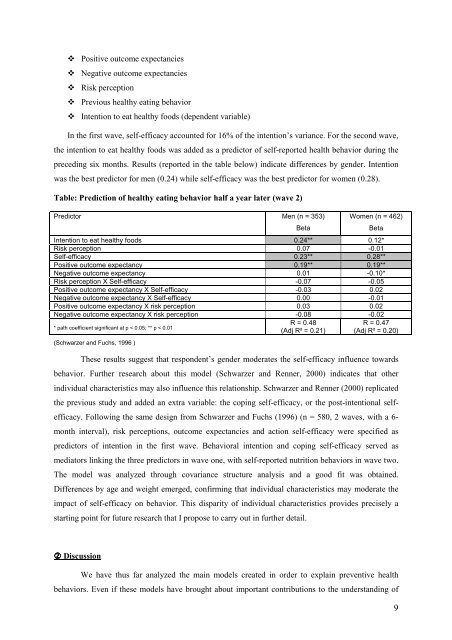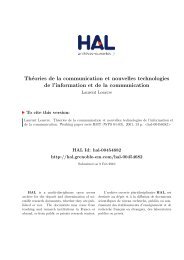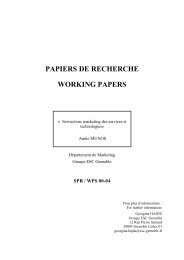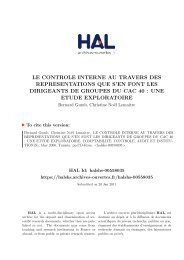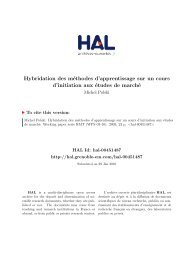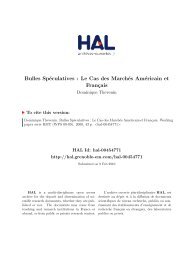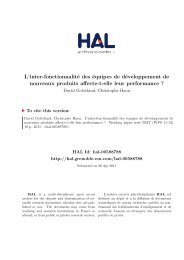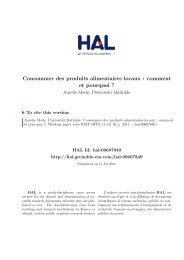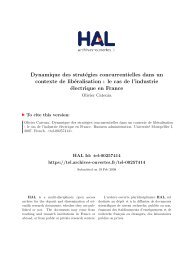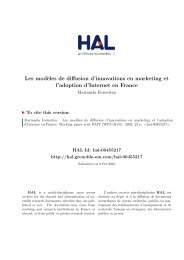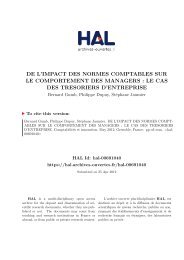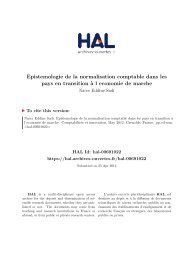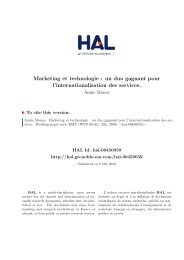The Determinants of Preventive Health Behavior: Literature Review ...
The Determinants of Preventive Health Behavior: Literature Review ...
The Determinants of Preventive Health Behavior: Literature Review ...
Create successful ePaper yourself
Turn your PDF publications into a flip-book with our unique Google optimized e-Paper software.
Positive outcome expectancies<br />
Negative outcome expectancies<br />
Risk perception<br />
Previous healthy eating behavior<br />
Intention to eat healthy foods (dependent variable)<br />
In the first wave, self-efficacy accounted for 16% <strong>of</strong> the intention’s variance. For the second wave,<br />
the intention to eat healthy foods was added as a predictor <strong>of</strong> self-reported health behavior during the<br />
preceding six months. Results (reported in the table below) indicate differences by gender. Intention<br />
was the best predictor for men (0.24) while self-efficacy was the best predictor for women (0.28).<br />
Table: Prediction <strong>of</strong> healthy eating behavior half a year later (wave 2)<br />
Predictor Men (n = 353)<br />
Beta<br />
Women (n = 462)<br />
Intention to eat healthy foods 0.24** 0.12*<br />
Risk perception 0.07 -0.01<br />
Self-efficacy 0.23** 0.28**<br />
Positive outcome expectancy 0.19** 0.19**<br />
Negative outcome expectancy 0.01 -0.10*<br />
Risk perception X Self-efficacy -0.07 -0.05<br />
Positive outcome expectancy X Self-efficacy -0.03 0.02<br />
Negative outcome expectancy X Self-efficacy 0.00 -0.01<br />
Positive outcome expectancy X risk perception 0.03 0.02<br />
Negative outcome expectancy X risk perception -0.08 -0.02<br />
* path coefficient significant at p < 0.05; ** p < 0.01<br />
(Schwarzer and Fuchs, 1996 )<br />
R = 0.48<br />
(Adj R² = 0.21)<br />
Beta<br />
R = 0.47<br />
(Adj R² = 0.20)<br />
<strong>The</strong>se results suggest that respondent’s gender moderates the self-efficacy influence towards<br />
behavior. Further research about this model (Schwarzer and Renner, 2000) indicates that other<br />
individual characteristics may also influence this relationship. Schwarzer and Renner (2000) replicated<br />
the previous study and added an extra variable: the coping self-efficacy, or the post-intentional selfefficacy.<br />
Following the same design from Schwarzer and Fuchs (1996) (n = 580, 2 waves, with a 6-<br />
month interval), risk perceptions, outcome expectancies and action self-efficacy were specified as<br />
predictors <strong>of</strong> intention in the first wave. <strong>Behavior</strong>al intention and coping self-efficacy served as<br />
mediators linking the three predictors in wave one, with self-reported nutrition behaviors in wave two.<br />
<strong>The</strong> model was analyzed through covariance structure analysis and a good fit was obtained.<br />
Differences by age and weight emerged, confirming that individual characteristics may moderate the<br />
impact <strong>of</strong> self-efficacy on behavior. This disparity <strong>of</strong> individual characteristics provides precisely a<br />
starting point for future research that I propose to carry out in further detail.<br />
Discussion<br />
We have thus far analyzed the main models created in order to explain preventive health<br />
behaviors. Even if these models have brought about important contributions to the understanding <strong>of</strong><br />
9


